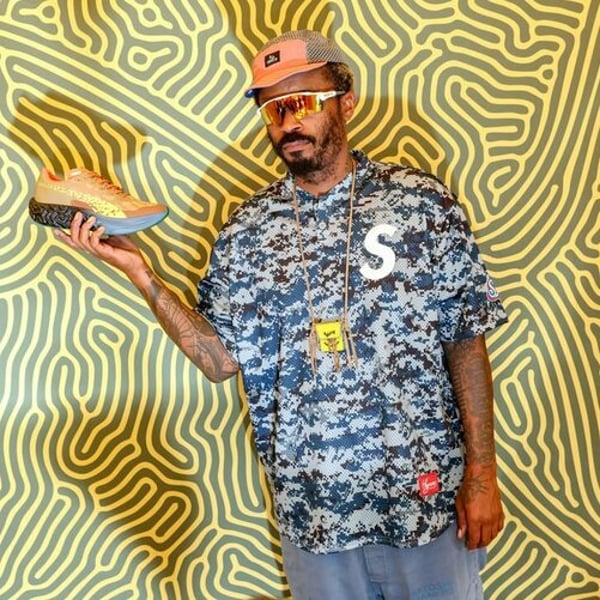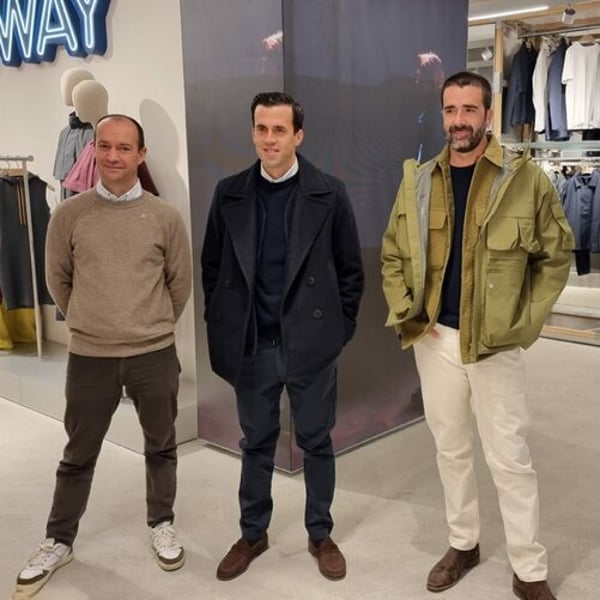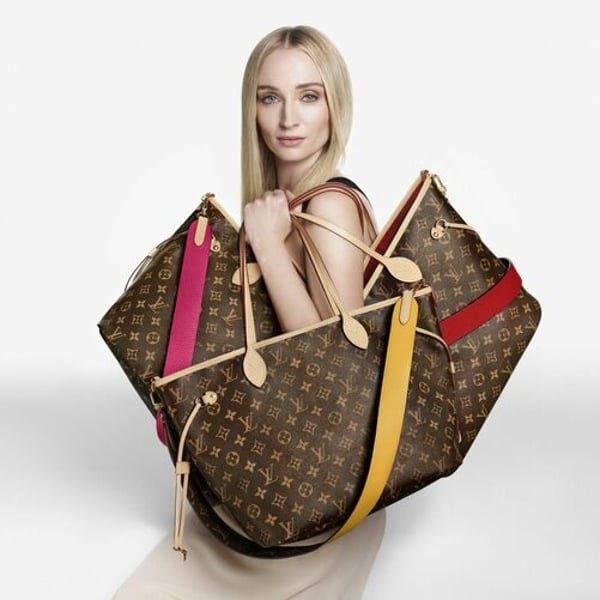In Paris, outside of Fashion Week shows, the city beats to the rhythm of brand initiatives that want to capture the effervescence of the French capital.
The Marais district comes alive with showrooms for international brands, while galleries and private mansions become fashion havens. Some are even opening up to the public, such as Puma, which on Wednesday inaugurated a pop-up store with an immersive installation in the colors of its new Velum model, imagined by star sneaker designer Salehe Bembury.
A hundred models were available for sale at the launch. The American designer, who earned his stripes in the industry at Yeezy alongside Kanye West during the brand’s heyday, was also present for the presentation. Renowned for his exploration of organic textures and original shapes, he brought his vision to Versace from 2017, for whom he created the Chain reaction model, but also to New Balance, Moncler Genius, and Crocs, to which he brought a fashion boost with his Pollex Clog with its biomorphic aesthetic. For FashionNetwork.com, the New York designer explains his creative approach.

FashionNetwork.com: Paris is in the midst of Fashion Week. Have you been to any shows this season?
Salehe Bembury: I saw three shows on Tuesday, including the Louis Vuitton show last night. It’s a brand with which I have a close relationship. So I’m always delighted to see what they develop. And the venue was incredible. It was at the Centre Pompidou. And, yes, it was great.
FNW: Here we are in the space dedicated to your Velum model for Puma. When did you start working with the brand?
S.B: We started working together at the beginning of 2024. Initially, the project was based on Hoops, Puma’s basketball line. The idea was to design products for their star athlete (American basketball player Tyrese Haliburton). But we saw opportunities in consumer demand. So we thought about how to address other audiences and satisfy other expectations. And I naturally thought of the running silhouette, with which I have a close relationship. It’s a truly universal silhouette because it’s as much about use as it is about lifestyle.
FNW: And how did you go about the project?
S.B: So I suggested doing something that could be developed in a shorter timeframe. The idea was not to create a product from scratch, but rather a Mr. Potato Head exercise. We took existing elements from the Puma range, then I injected some of my design sensibilities. And the result is this Velum.
FNW: But it’s very different to work on a performance foot and create a lifestyle product?
S.B: I’m no car expert, but I’d compare it to different ranges of the same model. Even if they’re similar, it’s in the engine and in the details that the differences lie. On the Velum, you have a plate in the stem that’s just decorative. On a performance model, you’ll have a carbon fiber plate, one of the elements that would make it functional. And on the Hali1, the integration of a carbon fiber plate makes it a very functional shoe. The specifications remain quite similar. But if you come across an obstacle or a problem, you have to use your design knowledge to solve it.
FNW: What was the brief for the Velum?
S.B: At Puma, the top technology is called Nitro. And it was the basis of the project around a running lifestyle silhouette. So even though it’s not a long-distance model, it retains its performance characteristics.
FNW: You’ve worked with several brands. How do you blend your creativity with the brand’s DNA?
S.B: It’s a question of balance. The first step in any design project is to research the history of the brand and its products. The value of a brand lies in its heritage. The fact that I’m able to use it and associate it with my stylistic identity is first and foremost an honor, but it’s also an opportunity to take their product and my identity to another level.
FNW: You’ve worked for both mass market and luxury brands. Is the creative approach different?
S.B: I studied industrial design. I was really taught that all design tasks are essentially the same. In reality, every brand is different and presents new opportunities. So it’s not a question of whether it’s a luxury brand or a mass market brand. It’s about identifying the DNA and knowing how to find something interesting to say. I’ve designed for a company called Payless, but also for Versace. And in terms of design execution, I think it was the same thing.
FNW: You’ve been in the industry for over 15 years. What is your perception of the sneaker market?
S.B: I think the current period is very open. We’ve come out of a few decades dominated by very specific brands. And I don’t think that’s the case anymore. For Puma, there are a lot of opportunities. The public is much more open-minded and curious about brands they may not have known before. This creates the possibility of making exciting products and creating great moments.
FNW: What subjects are of particular interest to you in your creative work?
S.B: For me, the most important element is the form. This may sound very simple, but I think there are a lot of brands that don’t necessarily manage it. That’s why, right after research, I always make sure to start by exploring the form. It’s special because the consumer can refer to it without even paying attention. That’s why it’s so important. If we look at the toe of your shoe and the toe of mine, there’s no need for a logo, because the shape recognizes the iconic Clarks toe and the iconic Puma toe. So it’s all about looking at the whole foot, from all angles, and making sure you’re executing to the best of your potential.
FNW: After Hoops and this Velum model, what is your commitment to Puma?
S.B: I can’t say. But for me, it’s all about long-term partnerships. I have the impression that we’re in a microwave consumer society where collaborations are totally ephemeral, ready to be reheated. With Puma, I see a long-term opportunity to keep the public engaged, to create a community, to tell stories. And, most important of all, to do cool things.
Copyright © 2025 FashionNetwork.com All rights reserved.







